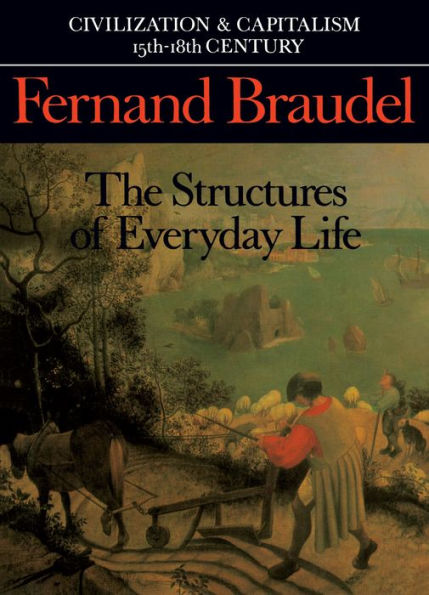Table of Contents
Introduction Preface 1 WEIGHT OF NUMBERS Guessing the world population Ebb and flow, The lack of statistics, How to calculate?, The equivalence of Europe and China, World population, Questionable figures, The relationship between the centuries, The old inadequate explanations, Climatic rhythms. A scale of reference Towns, armies and navies, A France prematurely overpopulated, Density of population and level of civilization, Other points inferred from Gordon W. Hewes' map, Wild men and animals. The eighteenth century: watershed of biological regimes Preserving the balance, Famine, Epidemics, The plague, The cycle of diseases, I400-1800: a long-lasting biological ancien regime. The many against the few Against the barbarians, The disappearance of the great nomads before the seventeenth century, The conquest of space, The resistance of cultures, Civilization against civilization. 2 DAILY BREAD Wheat Wheat and other grains, Wheat and crop rotation, Low yields, compensations and disasters, Increased cultivation and higher yields, Local and international trade in grain, Grain and calories, The price of grain and the standard of living, Bread of the rich, bread and gruel of the poor, To buy bread, or bake it at home?, Grain rules Europe. Rice Rice cultivated dry and in paddy fields, The miracle of the paddy fields, The importance of nee. Maize Well-ascertained origins, Maize and American civilizations. The dietary revolutions of the eighteenth century Maize outside America, Potatoes: a great future, Eating other people's bread. The rest of the world The people of the hoe, The primitive peoples. 3 SUPERFLUITY AND SUFFICIENCY FOOD AND DRINK Eating habits: luxury and the foods of the masses A belated luxury, Carnivorous Europe, The decline in meat consumption after 1550, Europe's privileged position, The extravagances of the table, Laying the table, The slow adoption of good manners, At the table of Christ, Everyday foods: salt, Everyday foods: dairy products, fats, eggs, Everyday seafoods, Cod fishing, The decline in the vogue for pepper after 1650, Sugar conquers the world. Drinks, stimulants and drugs Water, Wine, Beer, Cider, The belated popularity of alcohol in Europe, Alcoholism outside Europe, Chocolate, tea, coffee, Stimulants: the glories of tobacco. 4 SUPERFLUITY AND SUFFICIENCY: HOUSES, CLOTHES AND FASHION Houses throughout the world Rich building materials: stone and brick, Less favoured building materials: wood, earth, fabric, Rural dwellings in Europe, Urban houses and dwellings,The urbanized countryside. Interiors The lack of possessions of the poor, Traditional civilizations and unchanging interiors, The double pattern of Chinese furniture, In Black Africa, The West and its many different types of furniture, Floors, walls, ceilings, doors and windows, Chimneys and fireplaces, Furnaces and stoves, Furniture makers and the vanities of buyers, The domestic interior seen whole, Luxury and comfort. Costume and fashion When society stood still, If all the world were poor ... , Europe and the craze for fashion, Is fashion frivolous?, The geography of textiles, Fashion in the broad sense: long-term change, Conclusions? 5 THE SPREAD OF TECHNOLOGY: SOURCESOFENERGY,METALLURGY The key problem: sources of energy The human engine, Animal power, Wind engines and water engines, Sails: the European fleets, Wood, an everyday source of energy,Coal, Concluding remarks. Iron: a poor relation The beginnings of metallurgy, Progress between the eleventh and fifteenth centuries in Styria and Dauphine, Semi-concentrations, A few figures, Other metals. 6 THE SPREAD OF TECHNOLOGY: REVOLUTIQN AND DELAYS Three great technological innovations The origins of gunpowder, Artillery becomes mobile, Artillery on board ship, Arquebuses, muskets, rifles, Production and costs, Artillery on a world scale, From paper to the printing press, The invention of moveable type, Printing and history, The triumph of the West: ocean navigation, The navies of the Old World, The water routes of the world, The simple problem of the Atlantic. Transport Fixed itineraries, On not exaggerating the importance of transport problems, Water transport, Antiquated means of transport, Europe, Low speeds and capacities, Carriage and carriers, Transport: a brake on the economy. Problems of the history of technology Technology and agriculture, 430 -Technology in itself. 7 MONEY Imperfect currencies and economies Primitive currencies, Barter within monetary economies. Outside Europe: early economies and metallic money Japan and the Turkish Empire, India, China. Some rules of the currency game Competition between metals, Flight, saving and hoarding, Money of account, Stocks of metal and the velocity of monetary circulation, Outside the market economy. Paper money and instruments of credit Old practices, Cash and credit, Schumpeter's diagnosis:everything is money and everything i s credit, Money and credit: a language. 8 TOWNS AND CITIES Towns: the problems of definition Minimum size, combined weight, The everchanging division of labour, The town and its newcomers: mainly the poor, The self-consciousness of towns, Towns, artillery and carriages in the West, Geography and urban communications, Urban hierarchies, Towns and civilizations: the case of Islam. The originality of Western towns Free worlds, Towns as outposts of modernity, Urban patterns,Different types of development. The big cities The states, The function of capital cities, Unbalanced worlds, Naples, from the Royal Palace to the Mercato, St Petersburg in 1790,Penultimate journey: Peking, London from Elizabeth I to George III, Urbanization, the sign of modern man. CONCLUSION Notes Index




